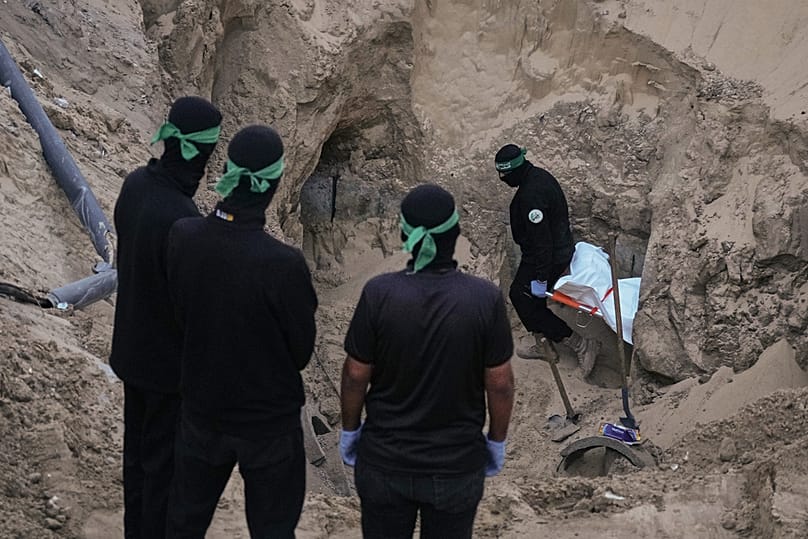Since the ceasefire took effect on 10 October, Hamas had released the remains of 17 hostages, with 11 remaining in Gaza before Sunday's handover.
The remains of three hostages returned to Israel from Gaza on Sunday have been identified as three soldiers who were killed in the 7 October 2023 Hamas-led attack, Israel said on Monday.
Health officials in Gaza said Israel also handed over the bodies of 45 more Palestinians.
The exchange marked another step forward for the tenuous, US-brokered ceasefire in the two-year war, the deadliest and most destructive ever fought between Israel and Hamas.
The office of Israeli Prime Minister Benjamin Netanyahu identified the three hostages returned to Israel on Sunday night as Omer Neutra, an American-Israeli, Oz Daniel and Assaf Hamami.
Earlier, a Hamas statement said the remains were found on Sunday in a tunnel in southern Gaza.
Since the ceasefire took effect on 10 October, Hamas has released the remains of 20 hostages, with eight now still remaining in Gaza.
For each hostage returned, Israel has been releasing the remains of 15 Palestinians. Monday's return brought the number of Palestinian bodies handed back since the ceasefire began to 270.
US President Donald Trump said he had spoken with Neutra's family, describing their relief and heartbreak.
"They were thrilled, in one sense, but in another sense, obviously, it’s not too great," Trump said.
Daniel, a 19-year-old staff sergeant, was pulled by militants from his tank and taken into Gaza, along with three others of his crew. He is survived by his parents and twin sister. The remains of the others were returned earlier.
Hamami, commander of Israel's southern brigade, died early on 7 October 2023, in fighting to defend Kibbutz Nirim. Hamami and two of his soldiers were killed and their bodies were taken to Gaza. Hamami is survived by his wife and three children.
Hamas has released one or two bodies every few days
Meanwhile, health officials in Gaza say they are struggling to identify bodies without access to DNA kits.
Only 75 of the Palestinian bodies returned since the ceasefire began have been identified, according to Gaza's Health Ministry, which has posted photos of remains in the hope that families will recognise them.
The hostages' remains exchange has been central to the initial phase of the US-brokered ceasefire.
The 20-point plan includes the formation of an international stabilisation force of Arab and other partners that would work with Egypt and Jordan on securing Gaza's borders and ensuring the ceasefire is respected.
Several countries have shown an interest in taking part in a peacekeeping force but have called for a clear UN Security Council mandate before committing troops.
Other challenging issues include the disarmament of Hamas and the method of the expansion of humanitarian assistance.
According to Israeli Prime Minister Benjamin Netanyahu, "there are still pockets of Hamas" in areas of Gaza under Israeli military control early on Sunday.
"There are actually two in Rafah and Khan Younis, and they will be eliminated," Netanyahu said during a Cabinet meeting.













